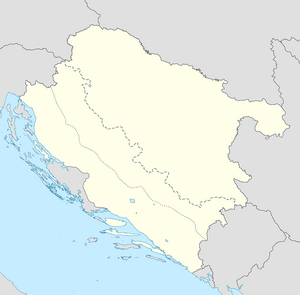Veljun massacre
| Blagaj massacre | |
|---|---|
| Part of World War II in Yugoslavia | |
|
A map showing the location of Blagaj within the NDH
|
|
| Location | Blagaj, Independent State of Croatia |
| Date | 9 May 1941 |
| Target | Serbs |
|
Attack type
|
Summary executions |
| Deaths | c. 400 |
| Perpetrators | Ustaše |
The Blagaj massacre was the mass killing of around 400 Serb civilians by the Croatian nationalist Ustaše movement on 9 May 1941, during World War II. The massacre occurred shortly after the German-led Axis invasion of Yugoslavia and the establishment of the Ustaše-led Axis puppet state known as the Independent State of Croatia (NDH). It was the second act of mass murder committed by the Ustaše upon coming to power and was part of a wider campaign of genocide against Serbs in the NDH that would last until the end of the war.
The victims were drawn from the village of Veljun and its surroundings, ostensibly for their involvement in the robbery and murder of a local Croat Catholic miller, Joso Mravunac, and his family. The Ustaše claimed that the murders were ethnically motivated and signalled the start of a regional Serb uprising. Following their arrests, the prisoners were detained in a Blagaj school, where many were beaten and tortured. The Ustaše intended to organize a mass trial of the men under the auspices of a "people's court". These plans fell apart after Mravunac's surviving daughter was unable to identify perpetrators from a police lineup and prosecutors declined to launch proceedings against any individual without evidence of their guilt. Dissatisfied, Vjekoslav Luburić, a senior Ustaše official, arranged for the creation of a new "special court" and appointed a prosecutor that was unwilling to let the lack of evidence hinder a conviction. The following day, the surviving Mravunac daughter allegedly identified one of the prisoners from a police lineup as being one of the perpetrators of the crime. This constituted sufficient reason to have 32 or 36 of the prisoners sentenced to death. The Ustaše went further and executed all of the men in their custody in a pit behind the Blagaj school, burying their bodies in a mass grave, which was subsequently covered with crops.
Following the massacre, the female relatives of the victims visited Blagaj carrying baskets of food for the prisoners, but were told the men had been sent away to Germany. After three months, a local Ustaše official captured by the Partisans admitted that the prisoners had in fact been killed. Memories of the massacre fostered animosity between the residents of Blagaj and Veljun that have lasted for decades. During the 1991–1995 war in Croatia, fought amid the breakup of Yugoslavia, the residents of the two communities destroyed and plundered each other's villages, and forcibly displaced one another. The inhabitants of the two villages began returning to the region after the war, but tensions persisted, and an attempt to commemorate the massacre in May 1999 resulted in the socialist-era monument to the victims being desecrated. Annual commemorations have since resumed.
...
Wikipedia

